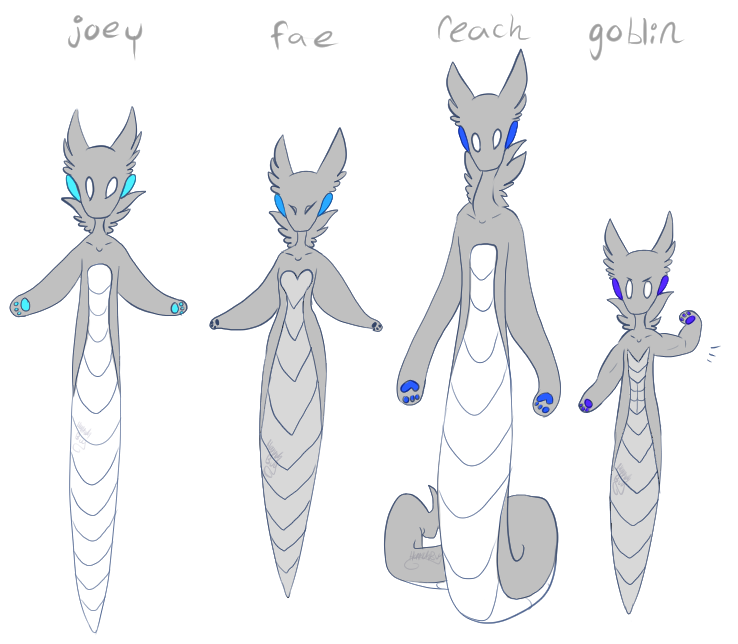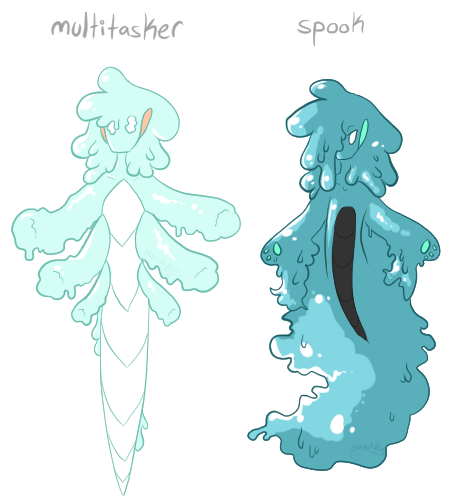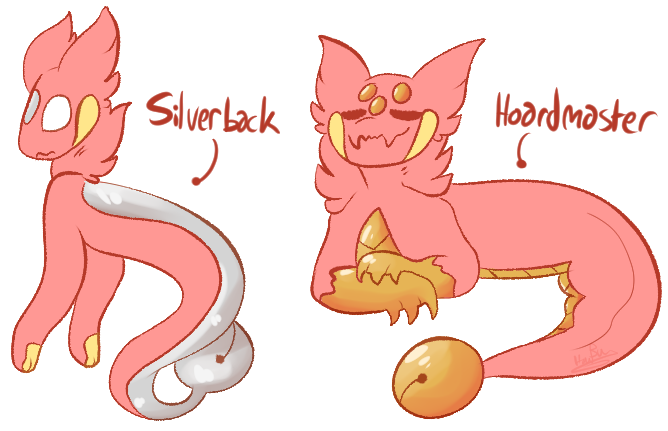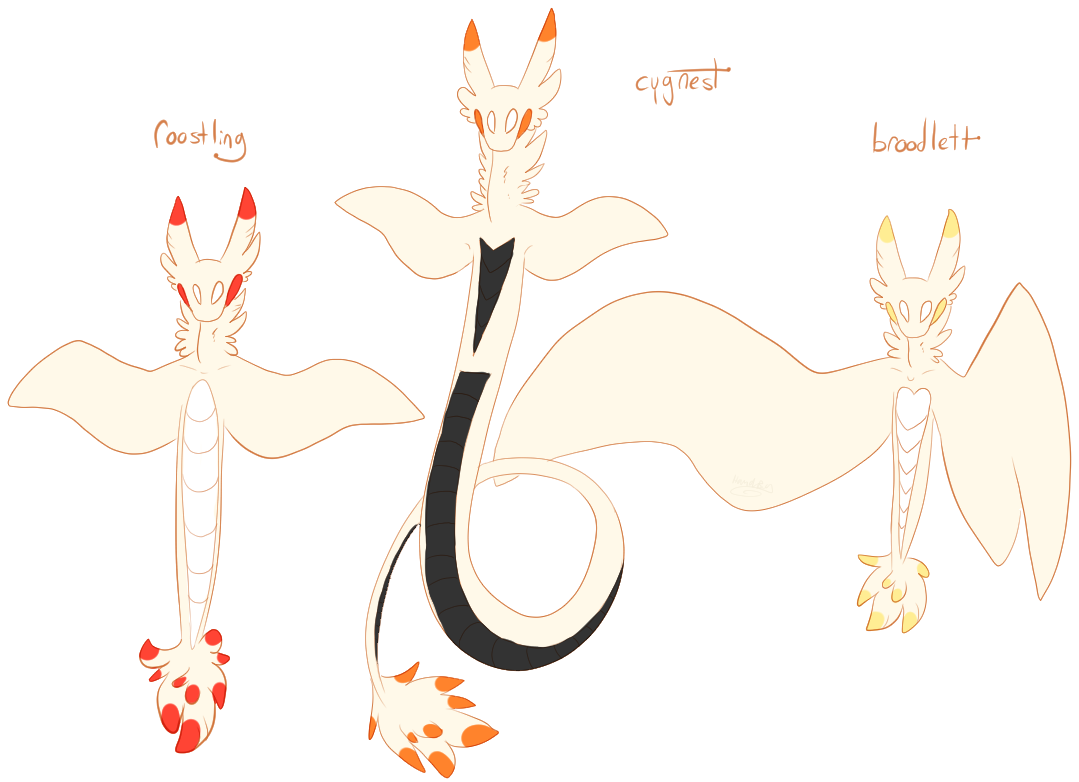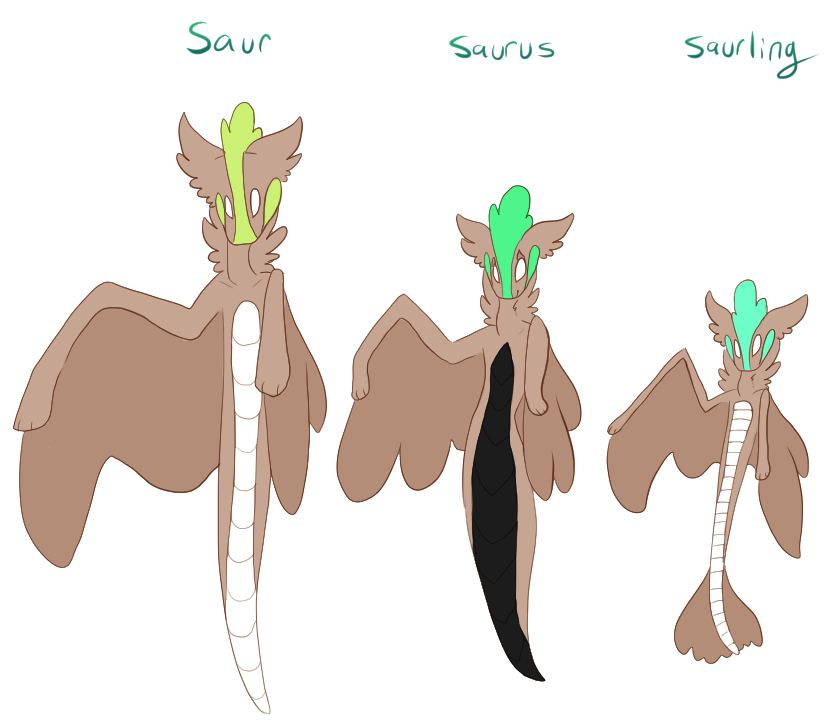 Fairy Pondskipper colors (so they don't take up so much space on their creation guide)
Fairy Pondskipper colors (so they don't take up so much space on their creation guide)
🌈 Red: The arm and tail membranes bear resemblance to a butterfly's wings, featuring large lobes accompanied by smaller decorative branches. The mouth is smooth, leaving them lacking teeth. Because of this, they tend to be fruit-eaters. The mane appears mostly regular except for two long tufts that trail down towards the waist. These flashy Skips are akin to tropical birds, doing well in environments with bright colors. They're known to try and impress others with flamboyant flight displays and flashing their membranes
🌈 Orange: The arm and tail membranes are jagged, sort of like a bat's wing, but lacking the fingers. A long mane runs from the base of the neck to down most of - if not all - the back. Mouths have two large, but blunt upper fangs, used to crack into tough surfaces. Orange Skips often dwell along coasts where they can feed on things like shellfish and crack open tough fruits
🌈 Yellow: The arm and tail membranes start as thick, rounded tendrils that look almost finger-like. In between the 'fingers' is a thinner connecting membrane. The mane is very long, draping over the shoulders and back. The mouth has a single, central tooth on the upper jaw. This helps them strip plant stalks to get at the good stuff inside. Yellow Skips tend to live in heavily flowered fields or forests where they can blend in with flowers. When the flowers die off for the winter, yellows will hibernate until their return
🌈 Green: The arm and tail membranes are thin and plentiful, almost looking like rows of feathers. The mane and hair are curled while the mouth has two small fangs on the lower jaw. Greens have the benefit of being able to hide in many places due to their coloration. However, they often prefer murky, scummed-over ponds where they use their teeth to scrape algae off rocks. They have a reputation for being lazy and good-natured, as their diet doesn't give them a lot of energy
🌈 Cyan: The arm and tail membranes are thick, rounded flaps capable of grasping onto things. They lack a mane, instead having elongated cheek tufts. The mouth has rows of small, somewhat blunt teeth - like a regular Snakekey minus their fangs. Cyans frequent the water and swampy areas with dense foliage where they often use their membranes to hang upside down from branches. They're capable of eating pretty much whatever they like, but seem to prefer...sleeping instead? Don't need energy if you don't use it, after all!
🌈 Blue: The arm and tail membranes are bat-like and ribbed with thin, straight fingers. Their mane is slightly shorter, with fluff concentrating around their paws instead. Their mouths are smooth with short, frilly tendrils at each end. Blue Skips spend the majority of their time underwater, usually at low depths. They use their mouth tendrils to stir up sand or dirt, searching for debris to eat. They may seem more skittish than other Skips and be quick to plop back into the water
🌈 Purple: The arm and tail membranes have curled, lacy edges (which can make them prone to snagging on things). They have a large, poofy mane accompanied by a long head tuft. The mouth has both top and bottom rows of shark-like teeth, which they actually use to grind rocks into bits small enough to eat. Purples are less environment-specific, instead preferring to live in and ol' open, flat area. This is both due to their inherent love of showing off and their desire to not get their membranes tangled up on things... Glass tends to be a favorite place to linger, as it satisfies both desires
🌈 Pink: The arm and tail membranes start with a small lobe before turning into a longer, slim lobe. The tips of the long lobe have three fleshy spike protrusions each, used to cling onto bark for an arboreal lifestyle. The mane is short while the ears are extra long (sometimes falling over because of it). Pinks have two big, vampire-like fangs used to puncture thick branches to feed on the sap inside. If not in the water, expect to find these guys among the leaves
🌈 Brown: Brown Skips have a single connected membrane running from wrist to tail tip like that of a sugar glider. The lack a mane, instead having long fluff along the front and back edges of their membrane. The mouth is vertical instead of horizontal with tiny, semi-sharp teeth. They favorite The Underground or caves in general where they nibble on mushrooms and insect pests that prey on the fungus. Their coloration makes it easy for them to blend in, too
🌈 White: The arm and tail membranes are like big, thick pancakes. They're vaguely rectangular in shape and capable of flying against powerful winds (er...relative to their size). The mane is averagely sized while the whole body is covered in short, velvety fur. These Skips are hardy, capable of living in cold, mountainous, and snowy environments. Their mouths are especially large, reaching past their eyes, but have only two little fang-like upper teeth. They use this to shovel as much snow (or water) into their mouths as possible, feeding on whatever meager nutritional value they can find in there. Much of their time is spent eating because of this
🌈 Grey: The arm and tail membranes are thin sheets with rippled edges. They're a bit more delicate than most other Skips, so Greys tent to extra-avoid conflict to protect themselves. Their mane wraps around their neck to form a super soft ruff and their mouths have an empty notch for their long, sticky tongue to protrude from. They will live wherever there are lot of flowers, as they feed on the nectar. However, they're not very tolerant to cold
🌈 Black: The arm and tail membranes are made from smooth, tough skin that take on a sort of manta ray-like shape. The tail has a tuft and the mouth is an 'x' shape, opening in four different directions. These skips are almost totally water-resistant and don't get wet easily. This allows them to dart quickly in and out of water with less drag, allowing them to uh...hunt small surface-dwelling water bugs. No, this isn't really acceptable in keke society, but the Skips seem to either be really bad at listening or not think what they're doing is especially bad. They tend to leave the water less than other Pondskippers and may never go further than the shores of their water their entire lives
